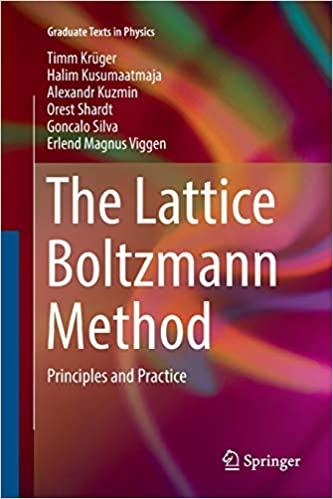Question
Implementing the Euler integrator, and testing it against the Strmer/Verlet In the lectures we also discussed, as an example of a poor algorithm for MD
Implementing the Euler integrator, and testing it against the Strmer/Verlet
In the lectures we also discussed, as an example of a poor algorithm for MD time integration, the Euler integrator. Let us now test its performance against the Strmer/Verlet scheme.
Task 2: Go through the below code cell, understand it, and then implement the Euler time integration algorithm by editing the (seven) lines marked by the comment #-- Edit this line.
Question 5: Note that here we take the initial velocities to be zero. Think: Does this correspond exactly to the same initial condition that we used in the Strmer/Verlet implemention above? Why / why not?
Answer 5: These two initial conditions are...??? Because...???
[ ]:
#-- initial positions:
x1 = 3.4
y1 = 2.1
z1 = 3.1
x2 = 2.7
y2 = 1.6
z2 = 3.7
#-- initial velocities:
vx1 = 0.0
vy1 = 0.0
vz1 = 0.0
vx2 = 0.0
vy2 = 0.0
vz2 = 0.0
#-- time integration details:
dt = 0.01 #-- time step
dt2 = dt**2 #-- time step squared
hdt2 = 0.5*dt2 #-- to save a multiplication in the innermost loop
startTime = 0 #-- from
endTime = 1000 #-- until (in number of steps)
# INITIALIZE vectors for output:
tOutEU = []
rOutEU = []
#-- simulate:
for time in range(startTime, endTime, 1):
#-- distance vector from the perspective of particle 1:
x12 = x2 - x1
y12 = y2 - y1
z12 = z2 - z1
#-- useful powers of the distance:
r12squared = x12**2 + y12**2 + z12**2
r12toSixth = r12squared**3
r12toTwelfth = r12toSixth**2
ljFactor = #-- Edit this line
#-- force on particle 1:
fx1 = x12*ljFactor
fy1 = y12*ljFactor
fz1 = z12*ljFactor
#-- force on particle 2:
fx2 = -fx1
fy2 = -fy1
fz2 = -fz1
# MOVE PARTICLES using Euler time integration:
#
# calculate the New positions:
x1 = #-- Edit this line
y1 = #-- Edit this line
z1 = #-- Edit this line
x2 = #-- Edit this line
y2 = #-- Edit this line
z2 = #-- Edit this line
# calculate the New velocities:
vx1 = vx1 + fx1*dt
vy1 = vy1 + fy1*dt
vz1 = vz1 + fz1*dt
vx2 = vx2 + fx2*dt
vy2 = vy2 + fy2*dt
vz2 = vz2 + fz2*dt
# save the time and the particle distance (so they can be plotted in the next cell):
tOutEU.append(time*dt)
r = np.sqrt(r12squared)
rOutEU.append(r)
[ ]:
plt.plot(tOutEU,rOutEU, label='Euler')
#plt.plot(tOutSV,rOutSV, label='Strmer/Verlet')
plt.axis(xmin=0,xmax=endTime*dt)
plt.xlabel('time (LJ-units)') plt.ylabel('distance between particles (LJ-units)') plt.legend(loc='upper left')
plt.show()
Question 6: Run the simulation using the initial positions from Question 3: 1=3.4, 1=2.1, 1=3.1 for the first particle and 2=2.7, 2=1.6, 2=3.7 for the second particle. Interpret again the distance-vs.-time plot: How does the behavior of the particles differ from what you saw when you started from the same positions with Strmer/Verlet in Question 3? Why?
Answer 6: Now the particles...??? Because...???
Step by Step Solution
There are 3 Steps involved in it
Step: 1

Get Instant Access to Expert-Tailored Solutions
See step-by-step solutions with expert insights and AI powered tools for academic success
Step: 2

Step: 3

Ace Your Homework with AI
Get the answers you need in no time with our AI-driven, step-by-step assistance
Get Started


